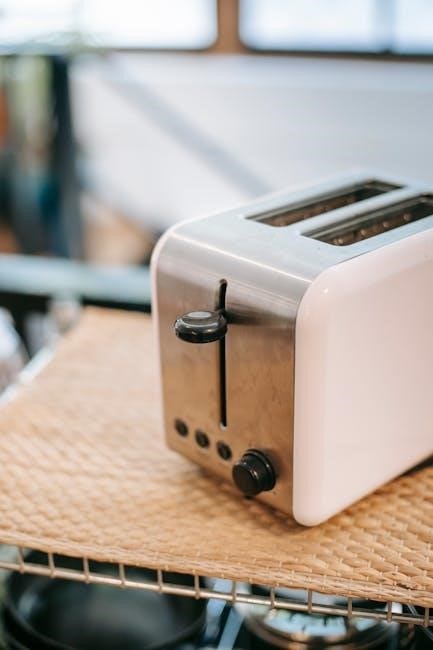A manual home elevator is a cost-effective, simplicity-focused solution for enhancing accessibility and convenience in residential spaces, offering a practical alternative to traditional elevators while maintaining safety and functionality.
1.1 What is a Manual Home Elevator?
A manual home elevator is a simple, non-automatic lifting system designed to transport people or items between floors. It typically relies on mechanical or hydraulic mechanisms, offering a cost-effective solution for residential accessibility. These elevators are often preferred for their ease of installation and operation, providing a practical alternative to traditional elevators while ensuring basic safety features and customization options to suit various home layouts and needs.
1.2 Benefits of Installing a Manual Home Elevator
Installing a manual home elevator offers enhanced accessibility, convenience, and cost-effectiveness. It provides a practical solution for mobility challenges, allowing easy movement between floors. These elevators are often more affordable than traditional models, with lower installation and maintenance costs. They also add value to your home while offering customization options to fit specific needs and space constraints, making them a versatile choice for homeowners seeking functional simplicity.
1.3 Brief History and Evolution of Home Elevators
The concept of home elevators dates back to the 19th century, evolving from basic manual systems to advanced motorized solutions. Early models relied on pulleys and levers, while modern innovations introduced hydraulic, electric, and pneumatic systems. This progression reflects a growing focus on accessibility, safety, and integration into home design, with manual elevators offering a simpler, cost-effective alternative for residential use.

Safety Concerns and Risks
Manual home elevators pose unique safety risks, including mechanical failures and improper installations, which can lead to accidents and injuries, emphasizing the need for strict adherence to safety protocols and professional oversight to ensure user protection and compliance with regulatory standards.
2.1 Potential Hazards of DIY Home Elevators
DIY home elevators pose significant safety risks, including mechanical failures, improper installations, and lack of essential safety features. These hazards can lead to accidents, injuries, or even fatalities. Additionally, DIY projects often bypass critical safety protocols and regulatory compliance, increasing liability; The complexity of elevator systems demands professional expertise to ensure reliability and safety, making DIY attempts highly discouraged due to the potential for catastrophic consequences.
2.2 Importance of Safety Features in Home Elevators
Safety features in home elevators are crucial to prevent accidents and ensure reliable operation. Essential mechanisms include emergency brakes, door interlocks, and overload sensors, which protect users from potential hazards. These features, often mandated by building codes, are designed to mitigate risks and provide peace of mind. Their inclusion is non-negotiable, as they directly impact the safety and well-being of everyone using the elevator.
2.3 Legal and Regulatory Compliance
Legal and regulatory compliance is essential for home elevators to ensure safety and avoid legal repercussions. Compliance involves obtaining necessary permits, adhering to local building codes, and passing inspections. Non-compliance can result in fines, legal action, and system removal. Professional installations typically handle these requirements, guaranteeing adherence to all relevant laws and standards, thereby protecting homeowners from potential liabilities and ensuring a safe operating environment.

Budgeting and Planning
Budgeting and planning are crucial for a successful manual home elevator project, involving assessing needs, creating a detailed budget, and navigating permit requirements to ensure compliance and efficiency.
3.1 Assessing Your Home Elevator Needs
Assessing your home elevator needs involves evaluating mobility requirements, space constraints, and budget. Consider the number of floors, weight capacity, and desired features like customization options. Measure stairwells or areas for potential installation to ensure compatibility. Prioritize safety and functionality while aligning with legal and regulatory standards to create a practical and efficient solution for your home.
3.2 Creating a Comprehensive Budget
Creating a comprehensive budget for a manual home elevator involves assessing material costs, labor expenses, and permit fees. Consider the elevator’s size, type, and features, as well as potential hidden costs like maintenance and repairs. Compare DIY kits with professional installations to determine the most cost-effective option while ensuring compliance with legal and safety standards.
3.4 Navigating Permit Requirements
Navigating permit requirements for a manual home elevator involves ensuring compliance with local, state, and federal building codes. Secure necessary permits before installation to avoid legal issues. DIY projects often fail to meet regulatory standards, risking fines or removal. Consult local authorities and professionals to ensure your elevator complies with safety and structural requirements, avoiding costly delays or penalties.

DIY vs. Professional Installation
Weighing DIY vs. professional installation for manual home elevators involves balancing cost, time, and safety, with professionals ensuring compliance and reliability while DIY may offer cost savings but higher risks.
4.1 Weighing the Risks and Rewards
Manual home elevators offer a balance of accessibility and affordability, but DIY installation poses significant risks, including safety hazards and legal non-compliance. While DIY may save costs initially, professional installation ensures reliability, safety, and adherence to regulations, making it a prudent choice for long-term peace of mind and functionality.
4.2 When to Choose Professional Installation
Professional installation is essential for manual home elevators when safety, reliability, and legal compliance are priorities. Experts ensure proper engineering, adherence to building codes, and integration of critical safety features, minimizing risks and ensuring long-term functionality. This approach is particularly crucial for complex systems or when accessibility needs are significant, guaranteeing a secure and efficient solution for homeowners.
4.3 Limitations of DIY Home Elevator Projects
DIY home elevator projects face significant limitations, including safety risks, legal non-compliance, and technical complexity. Without professional expertise, homeowners may overlook critical engineering details, leading to potential malfunctions. Additionally, DIY installations often lack necessary certifications and inspections, posing legal and insurance challenges. These factors make DIY projects inherently risky and less reliable compared to professional solutions.
Types of Home Elevators
Home elevators include hydraulic, electric motor, pneumatic, and rack-and-pinion systems, each offering unique advantages for enhancing accessibility and convenience in residential settings.
5.1 Hydraulic Elevators
Hydraulic elevators are a popular choice for their smooth, quiet operation and reliability. They utilize a hydraulic cylinder and pump system, making them ideal for heavy-duty use and consistent performance. Known for their durability, these elevators require regular maintenance to ensure optimal function. Their space-efficient design and proven track record make them a practical option for both commercial and residential applications.
5.2 Electric Motor and Sheave-Driven Elevators
Electric motor and sheave-driven elevators operate using a motor and pulley system, offering quiet and efficient performance. They are ideal for low-traffic environments and require less maintenance compared to hydraulic systems. These elevators are well-suited for residential use, providing a reliable and space-efficient solution for enhancing mobility within homes while ensuring smooth and consistent operation.
5.3 Pneumatic and Traction Systems
Pneumatic elevators use air pressure to lift, offering a quiet and space-efficient solution for small homes or attic installations. Traction systems rely on ropes and pulleys, providing a simpler, cost-effective alternative. Both systems are popular in DIY projects due to their relatively straightforward mechanisms, though they may lack the smoothness of hydraulic or electric systems and have limitations in load capacity and height.
5.4 Rack and Pinion Systems
Rack and pinion systems use a gear rack and pinion to move the elevator car, offering a durable and low-maintenance option; They are commonly used in DIY projects due to their simplicity and ease of installation. These systems are ideal for short distances and light loads, making them a practical choice for home elevators, especially in spaces with limited room for mechanical components.

DIY-Friendly Solutions
DIY-friendly solutions offer practical ways to enhance home accessibility with minimal complexity. Pre-manufactured lifts and compact designs simplify installation, allowing homeowners to achieve elevator functionality with ease and customization.
6.1 Light Modifications and Customization Options
Homeowners can personalize their manual home elevators through light modifications, such as adding enclosures or changing finishes, to blend seamlessly with their home decor. These customization options allow for a tailored look without compromising functionality or safety. This approach enables users to enhance aesthetics and comfort while maintaining the elevator’s primary function. However, any structural modifications should be done under professional guidance to ensure compliance with safety standards and building codes, striking a balance between personalization and reliability.
6.2 Pre-Manufactured Home Lifts
Pre-manufactured home lifts offer a convenient and efficient solution for homeowners seeking to enhance accessibility. These lifts are designed for easy installation and come with customizable features, ensuring a seamless integration into any home. They provide a cost-effective alternative to traditional elevators while maintaining safety and functionality, making them an ideal choice for those looking to improve mobility without extensive construction or high costs.
6.3 Compact and Space-Saving Designs
Compact and space-saving designs are perfect for homes with limited area, offering efficient vertical mobility without compromising on style or functionality. These elevators are tailored to fit snugly into small spaces, ensuring minimal disruption to the home’s layout. Their sleek profiles and versatile configurations make them an excellent choice for modern living, providing accessibility and convenience in even the most confined environments.
Legal Requirements and Permits
Installing a manual home elevator requires adherence to local building codes, permits, and safety regulations to ensure compliance and avoid legal repercussions, guaranteeing safe operation and structural integrity.
7.1 Building Codes and Regulations
Manual home elevators must comply with local, state, and federal building codes, ensuring safety and structural integrity. These regulations dictate design, installation, and maintenance standards, and non-compliance can result in fines or legal action. Permits are typically required, and inspections by certified professionals are mandatory to guarantee adherence to safety protocols and legal requirements.
7.2 Navigating Local, State, and Federal Laws
Navigating the complex landscape of local, state, and federal laws for manual home elevators requires careful understanding of each jurisdiction’s specific regulations. Compliance ensures safety and avoids legal penalties, while non-compliance can lead to fines or system removal. Consulting accessibility professionals is crucial to ensure all installations meet legal standards and pass necessary inspections.
7.4 Consequences of Non-Compliance
Non-compliance with legal and safety standards for manual home elevators can result in severe penalties, including fines, legal action, and mandatory removal of the system. Additionally, it may void insurance coverage and warranties, posing significant financial and legal risks to homeowners. Prioritizing compliance ensures safety and avoids these costly consequences.

DIY Home Elevator Projects
DIY home elevator projects offer a hands-on approach to improving accessibility, with detailed guides, parts lists, and inspiring examples empowering homeowners to create functional, personalized solutions.
8.1 Step-by-Step Guides and Instructions
Detailed step-by-step guides provide clear instructions for constructing a manual home elevator, emphasizing safety, proper planning, and precise execution. These resources often include diagrams, materials lists, and troubleshooting tips to ensure a smooth project flow. By following these instructions, homeowners can achieve a functional and personalized elevator system tailored to their specific needs and space constraints.
8.2 Parts List and Measurements
A comprehensive parts list for a manual home elevator includes a sturdy frame, pulleys, cables, a control panel, and safety mechanisms. Precise measurements are crucial to ensure proper fit and functionality. Detailed diagrams and specifications guide homeowners through the assembly process, emphasizing adherence to safety standards and structural integrity for reliable operation and durability over time.
8.3 Examples of Successful DIY Projects
Several homeowners have successfully installed manual home elevators, enhancing accessibility and convenience. A garage-to-attic elevator using a scaffold system and a loft elevator with detailed instructions are notable examples. These projects demonstrate cost-effectiveness and functionality, proving that with careful planning and execution, DIY solutions can meet specific needs while ensuring safety and reliability for years to come.

Safety Features and Maintenance
Manual home elevators require essential safety mechanisms like emergency brakes and overload sensors. Regular maintenance and inspections ensure reliability, while emergency backup systems provide added security and peace of mind.
9.1 Essential Safety Mechanisms
Manual home elevators must include critical safety features like emergency brakes, door interlocks, and overload sensors to prevent accidents. These mechanisms ensure safe operation by halting the elevator in case of malfunctions or excessive weight, protecting users from potential harm. Regular inspections and adherence to safety protocols are vital to maintain reliability and prevent incidents, ensuring a secure environment for all users.
9.2 Regular Maintenance and Inspection
Regular maintenance and inspection are crucial for ensuring the longevity and safety of manual home elevators. This includes checking wire ropes, lubricating moving parts, and testing safety mechanisms. Professional inspections should be conducted annually to identify potential issues early, preventing breakdowns and ensuring compliance with safety standards. A well-maintained elevator operates smoothly, providing reliable service and peace of mind for users.
9.3 Emergency Backup Systems
Emergency backup systems are vital for manual home elevators, preventing accidents during power outages or malfunctions. These systems, such as emergency brakes and battery-powered backups, ensure safe operation. Professional installations often include these features, adhering to safety codes and providing peace of mind. Regular maintenance is essential to guarantee their reliability and effectiveness in critical situations.

FAQs and Common Concerns
Addressing FAQs and common concerns about manual home elevators, this section explores safety, cost, and reliability, offering insights to help homeowners make informed decisions.
10.1 Is a DIY Home Elevator Truly Simple?
While DIY home elevators may seem simple, they involve complex engineering and safety risks. Even basic designs require precise mechanical and electrical expertise, making them far from straightforward. Online plans often lack necessary safety features and regulatory compliance, leading to potential hazards. Thus, DIY elevators are not truly simple solutions for home accessibility.
10.2 Can You Save Money with a DIY Elevator?
While DIY elevators may seem cost-effective initially, hidden expenses like potential errors, safety hazards, and legal issues can lead to higher long-term costs. Professional installations, though pricier upfront, often include warranties and ensure compliance with safety codes, making them more financially sound in the long run compared to risky DIY alternatives.
10.3 Where to Find Reliable Plans and Kits
Reliable DIY elevator plans and kits can be challenging to find, as many online resources lack proper engineering rigor and safety considerations. Reputable manufacturers and accessibility professionals often provide certified solutions, ensuring compliance with safety codes and regulations. Always prioritize verified sources to avoid potential risks and legal issues associated with uncertified designs.
10.4 What Parts Can Be Safely DIYed?
While DIY home elevator projects are risky, some parts can be safely customized, such as cosmetic modifications to the elevator cab or adding finishes. However, any alterations to mechanical, electrical, or structural components should only be handled by professionals to ensure safety and compliance with regulations. DIY adjustments to core systems can lead to safety hazards and legal issues.
Professional Installation and Alternatives
Professional installation ensures safety, compliance, and reliability, offering tailored solutions for accessibility needs. Reputable manufacturers provide high-quality systems, while alternatives like stairlifts or platform lifts offer practical solutions.
11.1 Benefits of Choosing Reputable Manufacturers
Reputable manufacturers ensure safety, compliance, and reliability, offering expertly designed and installed systems. They provide comprehensive maintenance, adhere to regulations, and deliver peace of mind, making them a superior choice over DIY risks.
11.2 Safer Alternatives to DIY Elevators
Pre-manufactured home lifts and compact elevator systems offer safer, code-compliant solutions. These alternatives minimize risks associated with DIY projects, ensuring proper installation and adherence to safety standards. They provide reliable accessibility while avoiding legal and technical challenges, making them a responsible choice for homeowners seeking convenience without compromising safety or regulatory compliance.
11.3 Consulting Accessibility Professionals
Engaging accessibility professionals ensures tailored solutions for your home elevator needs. Experts assess space, recommend suitable systems, and handle installations, guaranteeing compliance with safety codes; Their knowledge minimizes risks and optimizes functionality, providing peace of mind and long-term reliability for homeowners prioritizing safety and accessibility in their manual home elevator projects.
Manual home elevators offer a practical solution for accessibility, but prioritizing safety, compliance, and professional expertise is crucial to ensure reliability and peace of mind for homeowners.
12.1 Final Thoughts on Manual Home Elevators
Manual home elevators offer a blend of accessibility and convenience, empowering homeowners to enhance mobility while maintaining independence. While DIY projects may seem appealing, prioritizing safety, legal compliance, and professional expertise ensures long-term reliability and peace of mind, making them a worthwhile investment for modern living spaces.
12.2 Encouraging Safe and Responsible Choices
Prioritizing safety and legal compliance is crucial when considering a manual home elevator. While DIY projects may seem cost-effective, they often pose significant safety risks and legal challenges. Opting for professional installation ensures reliability and adherence to safety standards, safeguarding your investment and the well-being of your household. Expert guidance helps homeowners make informed decisions, ensuring their elevator is both functional and secure.

